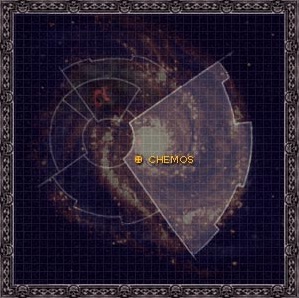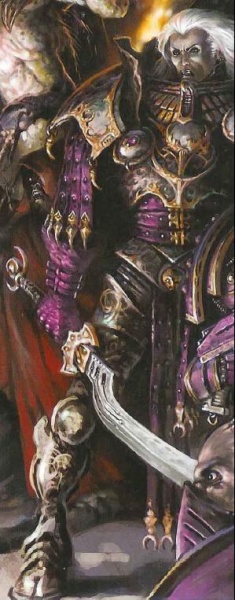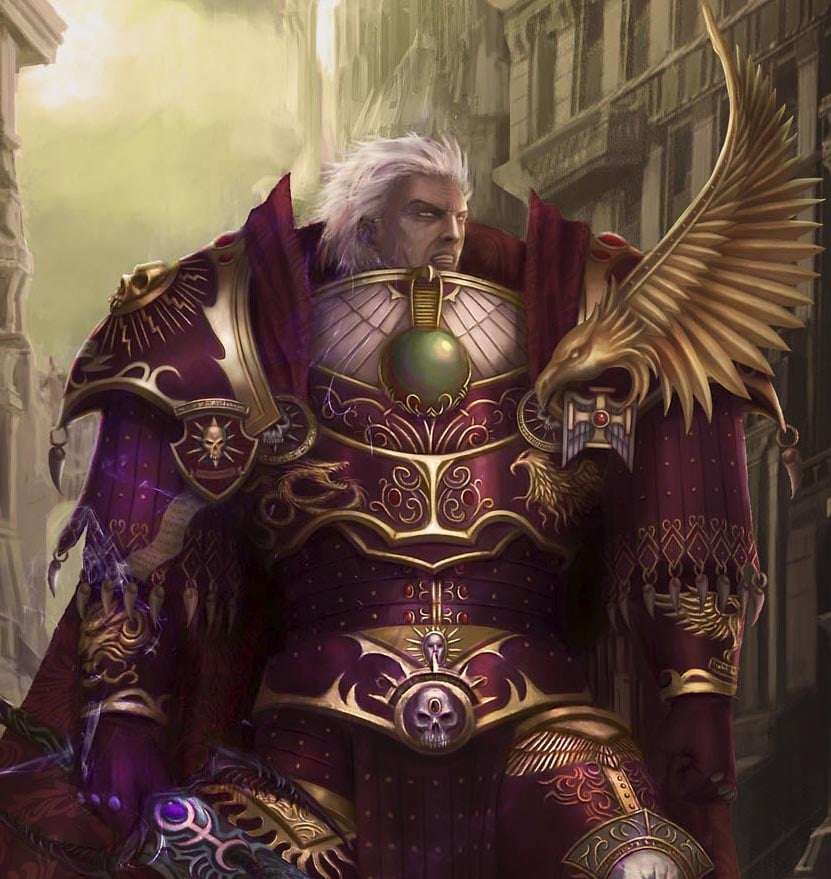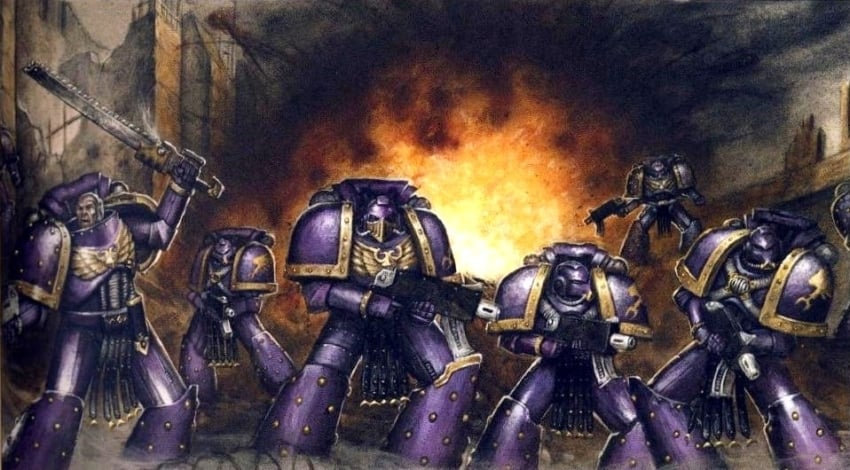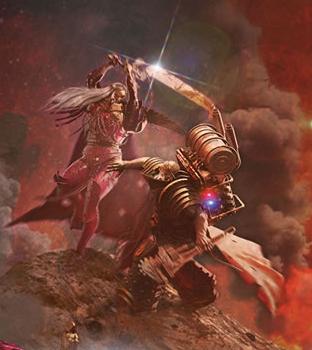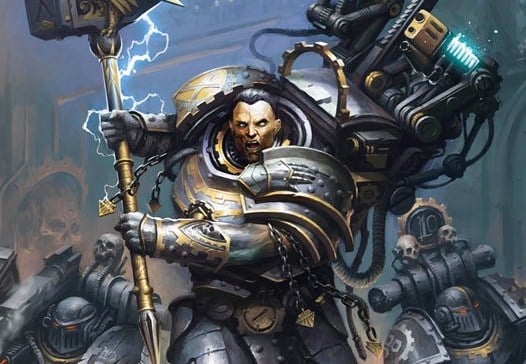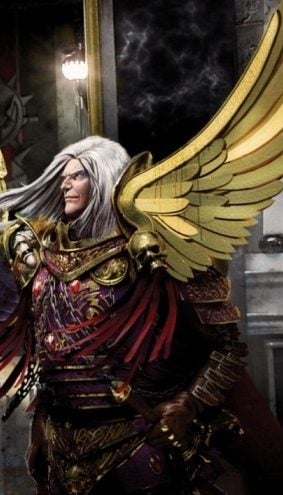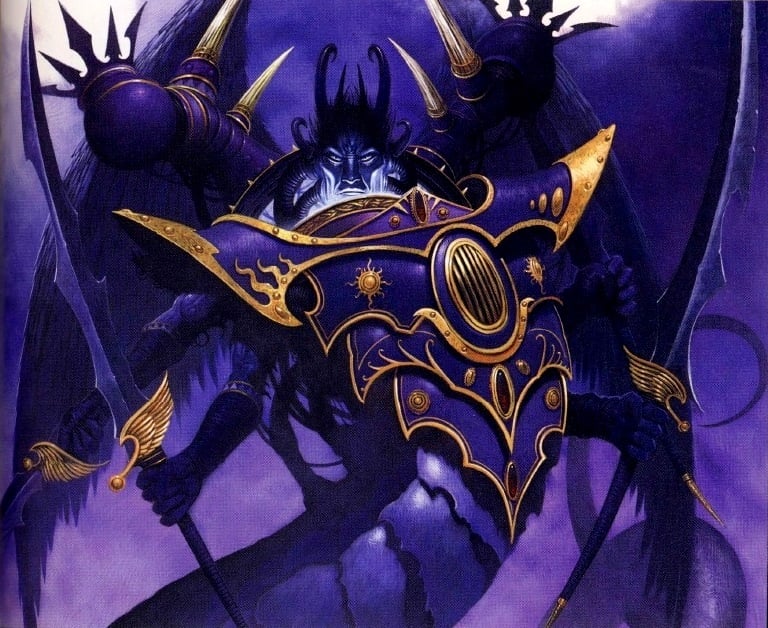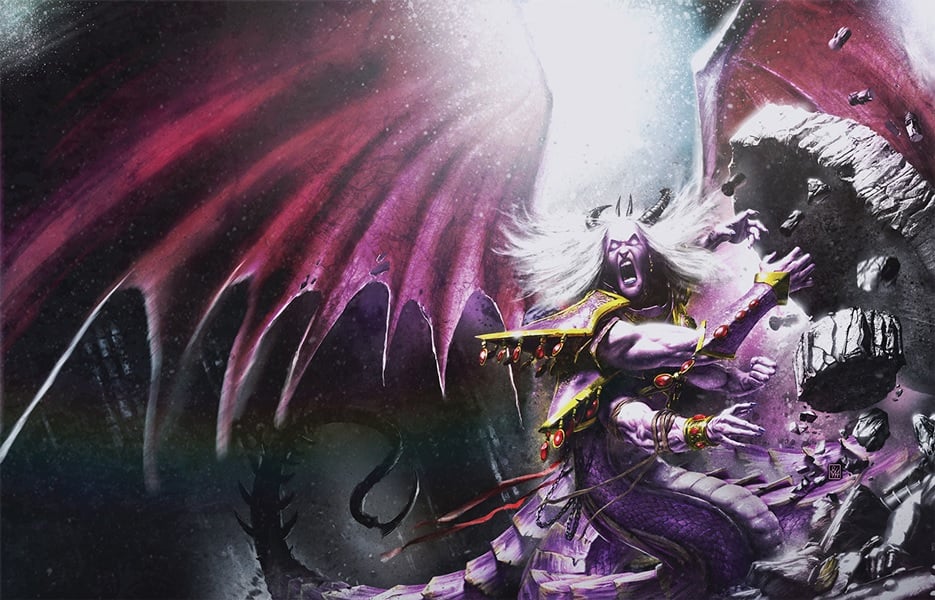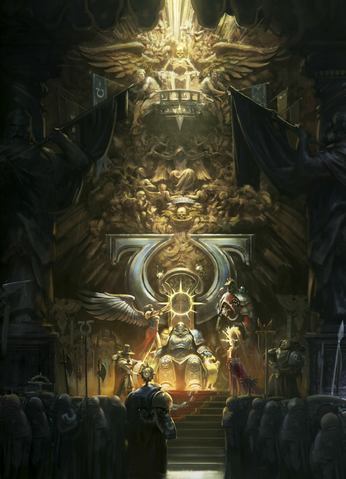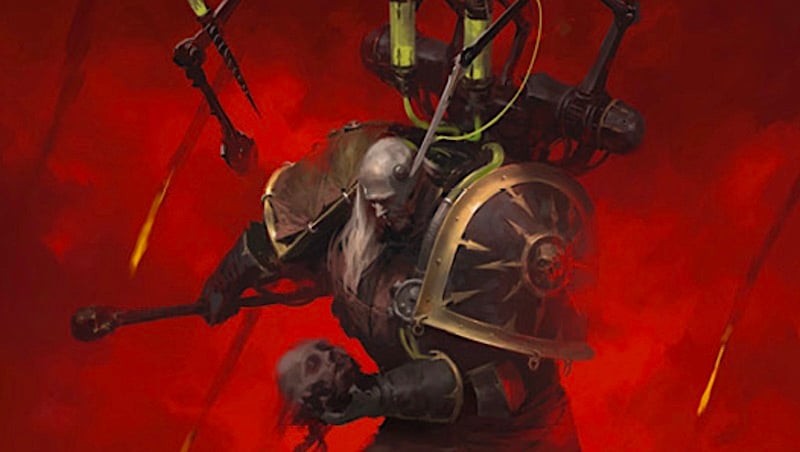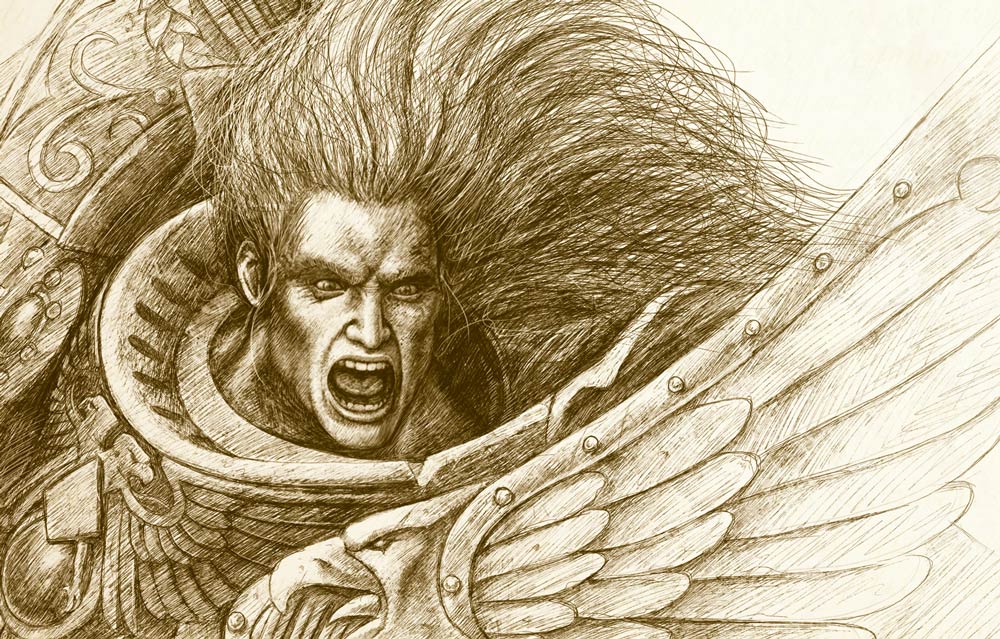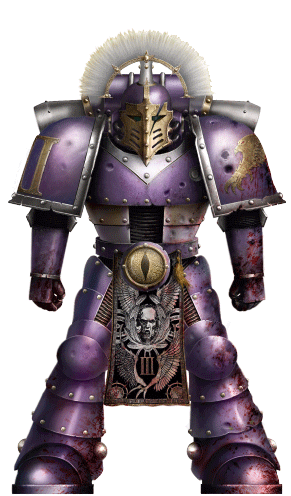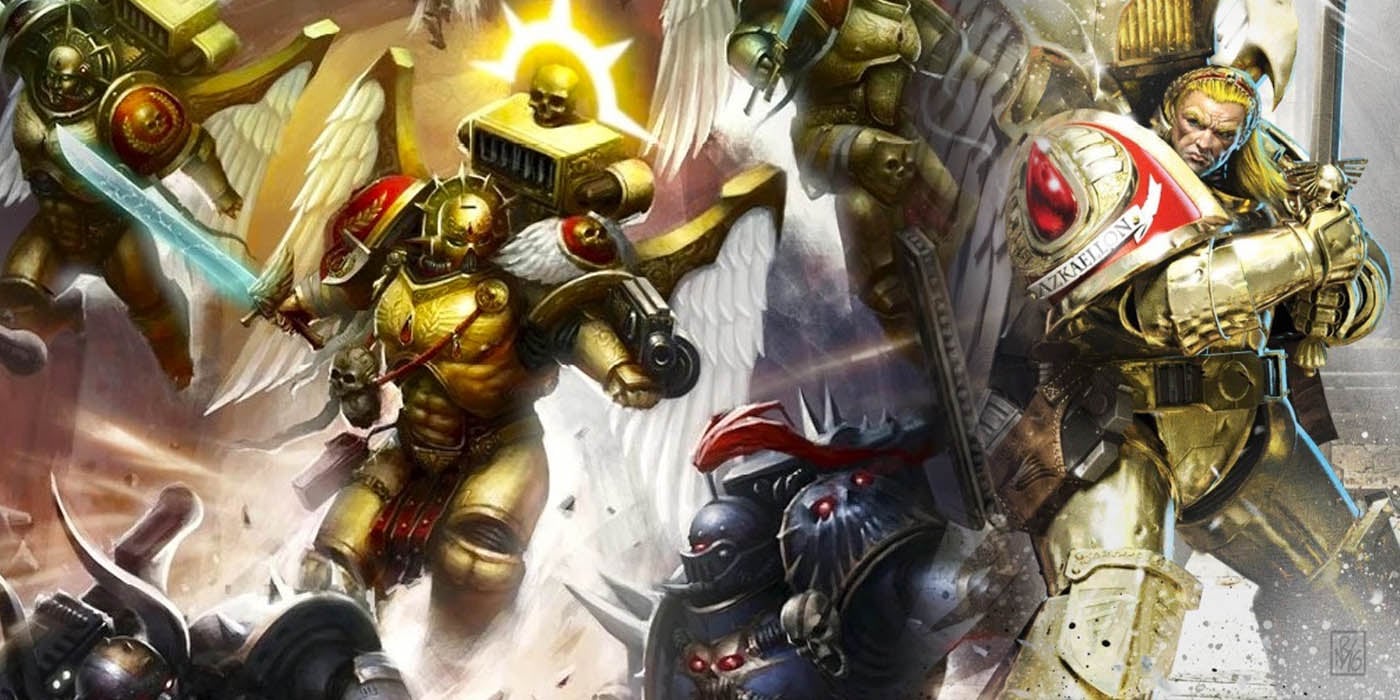Warhammer 40K: Fulgrim – The Primarch Who Fell Furthest
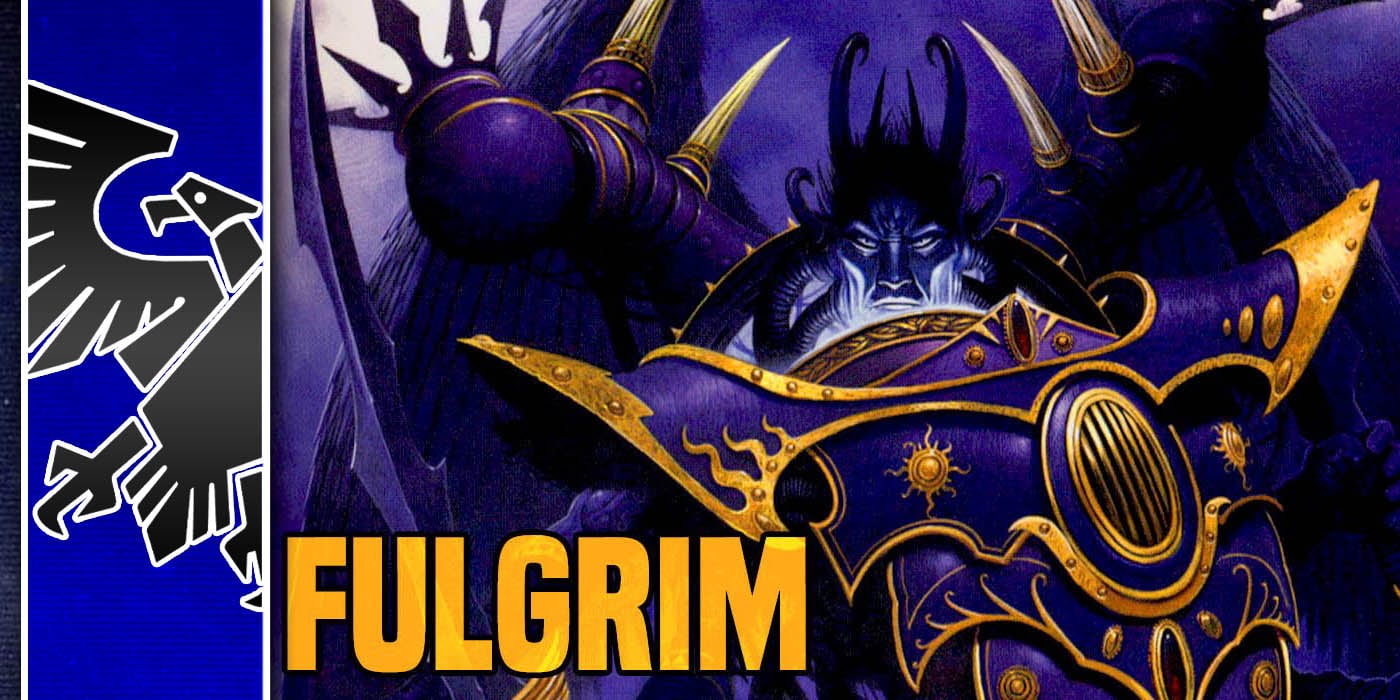
In his quest for perfection, one primarch fell the furthest of all the Emperor’s sons – Fulgrim of the Emperor’s Children.
Fulgrim (also known as the Phoenician, the Illuminator, the Prefector of Chemos) was one of the twenty Primarchs created by the Emperor in the earliest days of the Imperium, just after the end of the Age of Strife. Fulgrim, like the other Primarchs, was sucked from Terra by the Gods of Chaos and placed on a faraway world in an attempt to prevent the coming of the Age of the Imperium. Constantly seeking to emulate the Emperor by perfecting himself, Fulgrim’s obsession bred a hubris that drove him to eventually become consumed by the Chaos God Slaanesh.
Fulgrim’s Youth on Chemos
Tullea, Corrin, and Sullax were laborers of the resource-poor world of Chemos sent to investigate a meteorite impact. Sent without transport, the three had to take shelter from a wire-storm in an abandoned factory. When they reached the impact site, they didn’t find a fallen satellite or spacecraft, they found an ever-shifting mass of light. Sullax was wary, but Corrin felt that it was harmless. Corrin watched the light take shape and it touched his mind, learning everything he did, before it took the shape of a perfectly-formed baby boy. Sullax wanted to kill the child, seeing it as a burden on their resources, but the child had entranced Corrin and refused. Tullea shot Sullax and neither of them felt any guilt over killing him to save the perfect baby. Noticing that a stream of pure water had formed where the baby had landed, Corrin decided to name the child after the water-bringer of Chemos’s creation myth, Fulgrim.
Fulgrim spent his early years as a humble factory worker, but soon became a legend in his own right. At half the age of his fellow workers, he was able to fulfill his obligations to the continual running of the fortress-factory of Callax with ease. He quickly grew to understand the technology he had to work with and began to modify it, increasing efficiency dramatically. By the time he was fifteen years of age, Fulgrim had risen from the rank of worker to become one of the executives ruling the settlement. Learning of the gradual deterioration of both Callax and all the other settlements of Chemos, Fulgrim decided that he would save his world.
Under Fulgrim’s leadership, teams of engineers travelled far from their factory-fortress, reclaiming and repairing many of the far-flung mining outposts. As minerals poured back into Callax, Fulgrim supervised the construction of more sophisticated and energy-efficient machinery. As recycling efficiency grew to the point where Chemos was producing a surplus for the first time in years, Fulgrim began to foster a re-emergence of art and culture, aspects of humanity sacrificed in the struggle for survival. The other settlements allied themselves with Callax and, fifty years after arriving on Chemos, Fulgrim was its sole leader.
Fulgrim During The Great Crusade
It was not long after this that the planet’s isolation came to an end. From the grey sky came a flight of dropships, armored and battle-scarred, each bearing the same symbol, a two-headed eagle. On hearing of this, some fragment of memory stirred in Fulgrim. Chemos had no formal army, but the dropships’ landing zone had been surrounded by the Caretakers, the police-soldiers responsible for maintaining order in the factory-fortresses. Fulgrim sent word to the Caretakers to stand down and allow the visitors from above into Callax.
In his spartan quarters, Fulgrim was faced by armored warriors from the stars. Their faces bore the scars of many battles, and from their shoulders hung scrolls listing their achievements. Their armor and weapons were finely-worked, and their banners and pennants were works of art. Fulgrim recognized that these men were not merely advanced, but civilized — his lost brothers from the stars had preserved the arts he had longed to return to Chemos. From the midst of these warriors stepped their leader, the Emperor of Humanity. Fulgrim surveyed him and, without a word, knelt and offered his sword. On that day Fulgrim swore to serve the Imperium with all his heart. From the Emperor, Fulgrim learned of the distant world of Terra, of the Great Crusade to reclaim the sundered galaxy, and of his own origins. It is unknown when exactly this event occurred; however, it is recorded that the construction of a starship for the Primarch of the III Legion was completed around 160 years before the beginning of the Horus Heresy.
Traveling to Terra to meet his new Legion, Fulgrim learned that an accident had destroyed the majority of the gene-seed designated for his legion, and without their Primarch, replacing it was a slow and laborious process. Fulgrim came to address the two hundred Space Marines of his legion, and the words he spoke were said to inspire the Emperor so much that he named the legion the Emperor’s Children, and allowed them to bear the sign of the Aquila, the double-headed eagle that was the Emperor’s personal symbol, on their Power Armour.
Fulgrim became driven by the notion that his Legion should strive to live up to this honor and the perfection of the Emperor and his vision of Imperial culture. This drive to achieve perfection soon applied to all things the Primarch and his Legion became concerned with, from military tactics to the embrace of artistic culture that didn’t exist on Chemos to their very appearances. Fulgrim was a particularly imposing sight, with shimmering white shoulder-length hair, large, friendly-seeming eyes, and a mouth that was never far from a smile. His armor was of the finest quality, and intricately decorated. Over it he often wore one of a variety of high-collared cloaks.
Fulgrim was anxious to make his contribution to the Great Crusade, but the comparatively small size of his Legion meant that the Emperor’s Children were placed under the command of Horus and his Luna Wolves. Horus and Fulgrim grew close to one another while pacifying the Eastern Fringe. Eventually, swelled by recruits from both Chemos and Terra, Fulgrim was soon able to lead a crusade of his own, bringing countless worlds into the light of the Imperium. Fulgrim also established a close friendship with his brother Ferrus Manus, who also attempted to purge imperfection from himself. Ferrus and Fulgrim eventually came to each try to build the perfect weapon, resulting in Fulgrim crafting Forgebreaker and Ferrus Fireblade. The two exchanged weapons and they became synonymous with their respective Primarch’s thereafter. In the later stages of the Crusade the Emperor’s Children soon made a made for themselves during the Crusade, battling fearsome enemies such as the Megarachnids and Diasporex.
During this time, the Emperor’s Children initiated the Cleansing of Laeran, a campaign that required great effort, dedication, and sacrifice from the Imperial forces. At the conclusion of this campaign, Fulgrim acquired a trophy from the field of battle; a xenos-manufactured sword recovered from a Laeran temple known as the Silver Blade of Laer. He would begin to wield this sword more often than Fireblade, his customary personal weapon. With the benefit of hindsight, it can be recognized that the Laeran sword was a Daemon Weapon
The Horus Heresy
Fulgrim himself met with the renowned Farseer Eldrad Ulthran of Ulthwé on the Maiden World Tarsus, in which the Farseer attempted to warn Fulgrim of Horus’ grievous wounding at the hands of Eugen Temba and his Anathame, and how he was slowly beginning to turn to Chaos as he recuperated. Fulgrim reacted with outrage at the Farseer’s accusations due to his close friendship with Horus, second only to his bond with Ferrus Manus. This was spurred on by the influence of Fulgrim’s Laeran blade, which was infused with a Slaaneshi entity. Fulgrim furiously attacked Eldrad alongside his captains and the Phoenix Guard, destroying both Khiraen Goldhelm, an ancient and revered Wraithlord as well as an Avatar of Khaine in the process, forcing Eldrad and his beleaguered forces to withdraw. This victory to Fulgrim’s subsequent destruction of various Eldar maiden worlds using virus bombs as a means to end the supposed treachery of the Eldar.
Whilst the exact timing and placement of it varies between versions of the story, it is clear that Fulgrim soon met Horus in person, demanding a personal account of his actions. Instead, Horus was able to sway Fulgrim to his cause. Fulgrim’s respect for Horus allowed Chaos to find its way into Fulgrim’s heart, destroying Fulgrim’s loyalty to Terra, and replacing it with a burning desire to destroy the man who held humanity back from the perfection Fulgrim desired. Fulgrim was immediately sent to meet with Ferrus Manus, Primarch of the Iron Hands.
Great bonds of friendship and brotherhood existed between them, and Fulgrim felt that he could convince Ferrus of the righteousness of Horus’ cause. He was wrong, however, and their meeting did not go well, and concluded in violence. When next the brothers met, it would be as enemies. Their path chosen, the chaotic rot spread quickly, from Fulgrim to his lieutenants, the Lord Commanders of the Legion, then to company and squad leaders, and finally, all but a bare handful of Marines followed Slaanesh rather than the Emperor. Perfection became perfect hedonism. Fulgrim’s mental state quickly deteriorated, he began talking to a painting by Serena D’Angelus and killed the Sculptor Ostian Delafour after he inadvertently slighted the Primarch.
When the loyalist legions arrived in the Isstvan system, the Emperor’s Children were at the forefront of the fighting, aiding in the massacre of their former brethren. During the infamous Drop Site Massacre, Fulgim and Ferrus Manus met once again and had their final and fateful duel. Fulgrim wielded the weapon he had made for his brother, the Thunder Hammer Forgebreaker, while Ferrus did the same with the sword Fireblade. Though both weapons were shattered Fulgrim proved the victor after taking up his Silver Blade, but discovered he could not bring himself to kill his brother. It was at this point that the daemon bound within the Laeran blade fully exerted itself, and Ferrus Manus was struck dead. Fulgrim was shocked into clear-thinking by the death of his brother, aghast at what he had done and at the horrific betrayal and carnage around him.
In a further moment of weakness he agreed to the daemon’s offer to send him to oblivion and allowed the Warp-creature to escape from the sword. It took but a moment for it to possess his body and soul, trapping his consciousness in a tiny corner of his mind. From that moment on, Fulgrim became a prisoner in his own form, his existence fully controlled by the Slaaneshi daemon. Fulgrim’s soul was trapped in the twisted painting of Serena D’Angelus. The only person aware of the fate of Fulgrim was Horus, who recognized the Daemonic possession almost immediately during their next meeting but considered Fulgrim too valuable an asset to lose. Lorgar and Magnus also became aware of the true nature of Fulgrim upon encountering him.
However in the months afterward Fulgrim was able to regain his body by unknown means, trapping its essence in the same painting he had been trapped in. This was only revealed to his Legion when a group of Captains led by Lucius realised what had happened to their Primarch and took Fulgrim captive, he allowed them to do this to prove he was no longer possessed and tried to make the Daemon release its hold over him through extreme torture. Fulgrim revealed that he had forced the Daemon out and had been himself for some time, and had chosen to devote himself to Slaanesh fully and of his own free will.
Fulgrim & Daemonhood
Fulgrim soon joined forces with Perturabo, Primarch of the Iron Warriors on the world of Hydra Cordatus. Promising the Lord of Iron perfection, the two embarked on a quest to tip the balance of the rebellion in Horus’ favor by journeying into the Eye of Terror and retrieve a weapon known as the Angel Exterminatus. Shortly before they were to leave, Fulgrim was hit by a direct headshot from the vengeful Sisypheum crew member Nykona Sharrowkyn. Fulgrim survived the wound however thanks to the efforts of Fabius Bile. After a brief boarding battle with the Sisypheum that saw the ship escape yet again, the two Primarchs arrived in the Eye and quickly landed on the Crone World of Iydris. Entering an ancient Eldar citadel known as the Amon ny’shak Kaelis, the Emperor’s Children and Iron Warriors had to contend with an army of Wraithguard and Wraithlords that had awoken from their slumber.
At the height of the vicious battle Fulgrim attempted to betray his brother and slip away, but was pursued by Perturabo. Both soon arrived in a massive spherical chamber, and Fulgrim revealed to his brother that there was no Angel Exterminatus, but he rather was destined to become such a weapon on this world. Furious, Perturabo attempted to attack Fulgrim but was drained of his power when Fulgrim activated the Maugetar stone that Perturabo had previously received under the guise of a gift. Now with the Iron Warriors Primarchs’ power in hand, Fulgrim revealed the purpose of his plan: to achieve Apotheosis, better known as Daemonhood.
However just as Fulgrim was about to complete his ritual and achieve Daemonhood, Perturabo gathered enough strength to charge at his brother but were interrupted by an ambush of Salamanders, Iron Hands, and Raven Guard who had been stalking the traitor fleet in search of vengeance since the Drop Site Massacre. One of the loyalist Astartes during the battle shattered the Maugetar stone, freeing some of Perturabo’s energy and giving him the ability to strike down Fulgrim with his Thunder Hammer. However Perturabo only managed to destroy the Primarchs mortal skin and was reborn as a Daemon Prince of Slaanesh. Now a massive but elegant serpentine creature, Fulgrim told his brother that they would meet again then vanished in a burst of Warp energy along with his Emperor’s Children.
Horus’ rebellion spread, bringing the entire Imperium into civil war. All trace of decency amongst the Emperor’s Children had vanished by the time they partook in the Siege of Terra. While other Traitor Legions assaulted the Imperial Palace, the Emperor’s Children embarked upon a spree of terror and gratification amongst the helpless citizenry of Terra. Under Fulgrim, billions of defenseless civilians were used as experimental subjects in the effort to create ever-more powerful stimulants and pleasure-inducing chemicals, used to suffer daemons, or were simply killed to sate the bloodlust of the Legion.
Post-Heresy
When Horus was defeated by the Emperor, the Emperor’s Children left a trail of depopulated worlds in their wake as they fled towards the Eye of Terror. As their supply of slaves was exhausted, they resorted to raiding the other Traitor Legions for fresh meat, leading to a series of conflicts known as the Legion War. Fulgrim was seen in combat a century after the Heresy at the Battle of Thessala with Roboute Guilliman, the Primarch of the Ultramarines, where he slashed his brother’s throat and laid him low with a fatal poison, before disappearing from records for many centuries.
The Emperor’s Children claimed that Fulgrim was gifted by Slaanesh with a hidden world of unlimited pleasure for him to rule. Several centuries after the Heresy, he was said to be asleep on this world and not active in guiding the Emperor’s Children. Warbands of Emperor’s Children, other Slaanesh-worshiping Chaos Space Marines and Cultists, and the Imperial Inquisition have sought out this world, but none have returned. Abaddon the Despoiler was also able to somehow find Fulgrim and was able to gain the favor of Slaanesh by trading an unblemished Pythosian Psyker with the Primarch.
During the Thirteenth Black Crusade, it is thought that Fulgrim appeared to massacre Imperial Guard during the Cacophony of Extremis Six.
Fulgrim made another appearance at the conclusion of the Ultramar Campaign in the closing days of M41. Through the efforts of the Mechanicum and Eldar Roboute Guilliman was healed from the wounds inflicted by Fulgrim. Fulgrim sensed his brother’s revival and took the time to possess the Arch-Consul of Macragge in order to gloat to Guilliman during his first public appearance in ten thousand years. Through the body of the Arch-Consul, Fulgrim announces that Guilliman would have many temptations to resist and that any feeling of self-satisfaction would be his doom.
At some point in the 41st Millennium, Fulgrim was lured back to Isstvan III by a sonic beacon. There he was confronted by the sole surviving loyalist Emperor’s Children, the Dreadnought Rylanor. As Fulgrim tore the Dreadnought apart, an unexploded Virus Bomb was detonated and engulfed the planet. Though Fulgrim’s form survived, his pride was wounded.
Fulgrim’s Perfect Clone
Sometime before M41, Fabius Bile managed to create a perfect clone of Fulgrim. Unlike all previous attempts, this clone was pure and uncorrupted, with not even a hint of the warp affecting him. Why this one had succeeded was unknown, even to Fabius. The clone aged to adulthood quickly, his Primarch genetic memory allowing him to learn quickly, as well as remember the events of the Horus Heresy. Expressing regret for his actions and downfall, he swore to wipe away the sins of his past and atone for his treason. This Fulgrim was taken by the Necron Trazyn the Infinite when Fabius betrayed him, fearing the clone would go down the same route as before.
Personality
Before the Heresy, Fulgrim was a warrior that enjoyed the finer arts of civilization and culture of his people such as art, music, and celebration. He believed that there was little point in conquering the galaxy if they did not indulge in these civilized traits. Fulgrim himself also engaged in the arts and created marble statues of his two three first captains though he felt that his work was not perfect.
One of Fulgrim’s noted character traits which were adopted by his Legion was the quest for perfection. He believed that Mankind was the perfect creation and that they must strive to emulate his father, the Emperor. As such, he was greatly angered whenever this goal was challenged. He demonstrated this in his hostility to adopting the Laer as a protectorate and believed that only Humanity had the right to rule. There was, however, a flaw here as he secretly believed that there was something wrong with him and his Legion due to the near-disaster that claimed half their number before the start of the Great Crusade. This allowed others to exploit him and was the reason why he accepted Fabius Bile‘s genetic treatments of the Legion.
Among his fellow Primarchs, Fulgrim’s friendships were deepest with Ferrus Manus and Horus though the former was a stronger bond.
Wargear
Fulgrim wielded many weapons throughout the Heresy. He is perhaps most famous for the Silver Blade of Laer, the Daemonic weapon that drove him to corruption. However, before wielding this weapon, his primary weapon was Fireblade, a Power Sword built for him by Ferrus Manus. After the Battle of Isstvan III, Fulgrim also came into the possession of the Anathame. During the Drop Site Massacre, Fulgrim effectively wielded Manus’ Thunderhammer Forgebreaker for a time. Fulgrim’s personal firearm was the Volkite Charger Firebrand, while is Power Armour was an ornate artistically crafted suit known as the Gilded Panoply
Learn More of the Emperor’s Children
Lexicanum
~When will the Phoenecian return? And what of his Loyalist clone – now in the hands of the Necrons?

